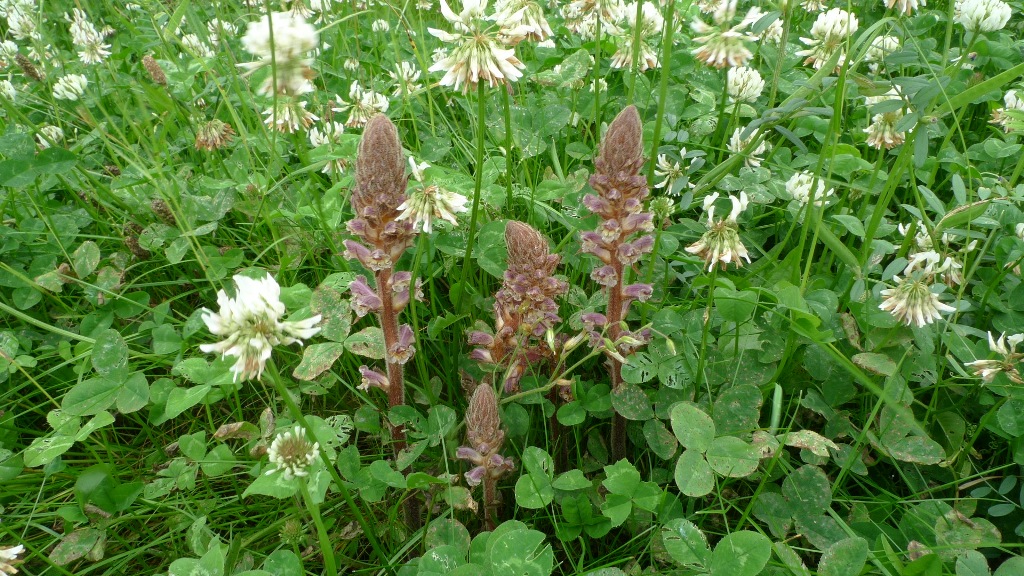
The Orobanchaceae or Broomrape family, has been seperated from the former Scrophulariaceae as it was:
‘a long-expressed opinion that these semi-parasitic Scrophulariaceae (tribe Pedicularieae) should be placed with the totally parasitic Orobanchaceae, which was confirmed by molecular studies’ (in Stace).
In former posts I’ve covered the Veronicaceae as well as Plantaginaceae which also split from the once much larger Scrophulariaceae family.
These are fascinating plants and in this post I hope to find out about all their uses to men as well as for wildlife and their interacting hosts.
Click links in the contents for more info and pictures from various websites. The scientific name usually has a link from the Online Atlas of the British Isles and Irish Flora. The common name mostly has a UK link or Wikipedia.
Background colours are meant for easier reading. A pink background means a warning (such as poisonous!) or medicinal use, green for edible, ornamental or other uses and blue for habitat where it can be found in B.I. , and just for interesting facts or wildlife use.
If the plants are found in the Flora of Birmingham and the Black Country a FBBC will be added behind the Common name in the contents page below.
Pictures with thanks by Matt Summers (M. S.), Mike Poulton (M. P.) of Ecorecord and Wikipedia Commons.
Their are now 10 genera in the Orobanchaceae or Broomrape family, described in Stace:
Contents:
Melampyrum spp or Cow-wheat
- M. cristatum or Crested Cow-wheat
- M. arvense or Field Cow-wheat
- M. pratense or Common Cow-wheat with 2 ssp.: – ssp. pratense FBBC and – ssp. commutatum
- M. sylvaticum or Small Cow-wheat
Euphrasia spp or Eyebrights
This is a complex genus with many species as well as hybrids! Stace divides them in 3 groups to make them easier to identify. Most species listed below have a narrow range where they grow.
Group 1: Subsection Euphrasia
- E. officinalis sensu lato or Common Eyebright FBBC
- E. rivularis or Cumbrian Eyebright
- E. vigursii or Cornish Eyebright
Group 2: Subsection Euphrasia
- E. arctica or Arctic Eyebright
- E. tetraquetra or Western Eyebright
- E. nemerosa or Common Eyebright FBBC
- E. pseudokerneri or Chalk Eyebright
- E. confusa or Confused Eyebright
- E. frigida or Upland Eyebright
- E. foulaensis or Foula Eyebright
- E. cambrica or Welsh Eyebright
- E. ostenfeldii or Ostenfeld’s Eyebright
- E. marshallii or Marshall’s Eyebright
- E. rotundifolia or Pugley’s Eyebright
- E. campbelliae or Campbell’s Eyebright
- E. micrantha or Slender Eyebright
- E. scottica or Scottish Eyebright
- E. heslop-harrisonii or Heslop-Harrison’s Eyebright
Group 3: Subsection Angustifoliae
- E. salisburgensis or Irish Eyebright
- E. septentrionalis
Odontitis vernus or Red Bartsia FBBC
- O. vernus ssp. vernus
- O. vernus ssp. serotinus
- O. vernus ssp. litoralis
O. jaubertianus or French Bartsia
Bartsia alpina or Alpine Bartsia
Parentucellia viscosa or Yellow Bartsia FBBC
Rhinanthus minor or Yellow-rattle FBBC
- R. minor ssp. minor
- R. minor ssp.stenophyllus
- R. minor ssp. monticola
- R. minor ssp. calcareus
- R. minor ssp. lintonii
- R. minor ssp. borealis
R. angustifolia or Greater Yellow-rattle
Pedicularis palustris or Marsh Lousewort FBBC
P. sylvatica or Lousewort FBBC
- P. sylvatica ssp. sylvatica
- P. sylvatica ssp. hibernica
Lathraea squamaria or Toothwort FBBC
L. clandestina or Purple Toothwort
Orobanche sps. or Broomrapes
- O. rapum-genistae or Greater Broomrape
- O. caryophyllaceae or Bedstraw Broomrape
- O. elatior or Knapweed Broomrape
- O. alba or Thyme Broomrape
- O. reticulata ssp. pallidiflora
- O. crenata or Bean Broomrape
- O. hederae or Ivy Broomrape
- O. picridis or Oxtongue Broomrape
- O. minor or Common Broomrape with 2 ssp: FBBC
- O. minor ssp. minor and
- O. minor ssp. maritima
Phelipanche ramosa (syn. Orobanche ramosa)
P. purpurea or Yarrow Broomrape
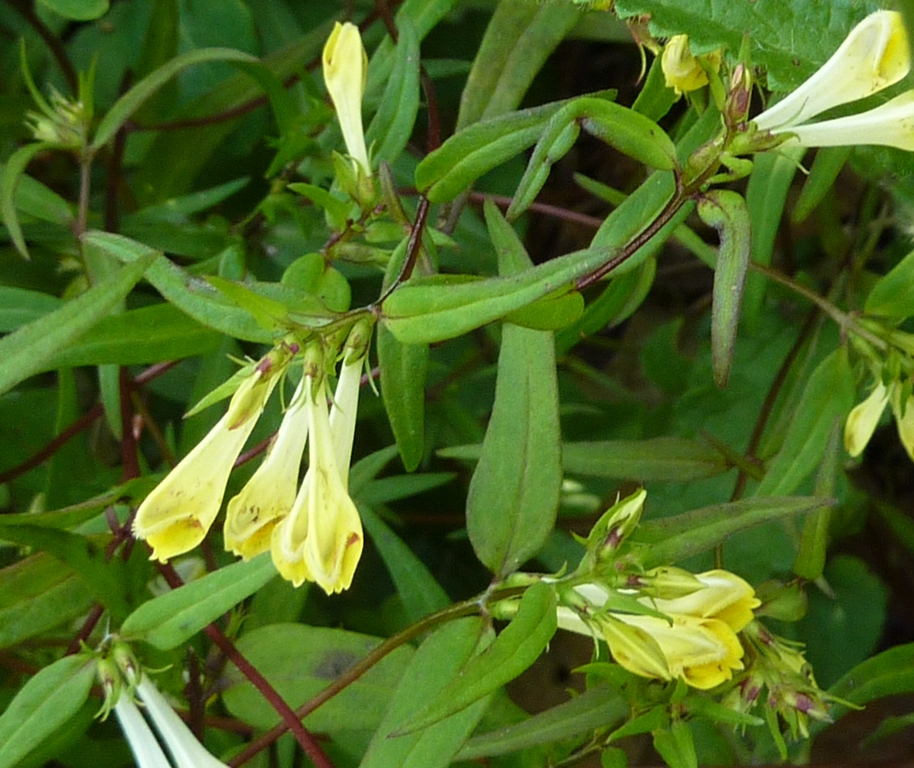
Melampyrum pratense or Common Cow-wheat (by M. S.)
Melampyrum spp or Cow-wheat
Melampyrum is a genus of about 20 species of herbaceous flowering plants in the family Orobanchaceae known commonly as cow wheat. They are native to temperate regions of the Northern Hemisphere. They are hemiparasites on other plants, obtaining water and nutrients from host plants, though they are able to survive on their own without parasitising other plants.
Melampyrum species are used as food plants by the larvae of some Lepidoptera species, including the mouse moth (Amphipyra tragopoginis).
- M. cristatum or Crested Cow-wheat
- M. arvense or Field Cow-wheat (Neophyte)
- M. pratense or Common Cow-wheat with 2 ssp.: – ssp. pratense and – ssp. commutatum
An annual hemiparasite of woods, scrub, heaths and upland moorlands on well-drained, nutrient-poor acidic soils; more rarely in scrub, hedgerows and deciduous woodland on chalk and limestone. The large seeds are distributed by ants.
M. pratense herb has been used in traditional Austrian medicine internally as tea or externally as pillow filling for treatment of rheumatism and blood vessels calcification.
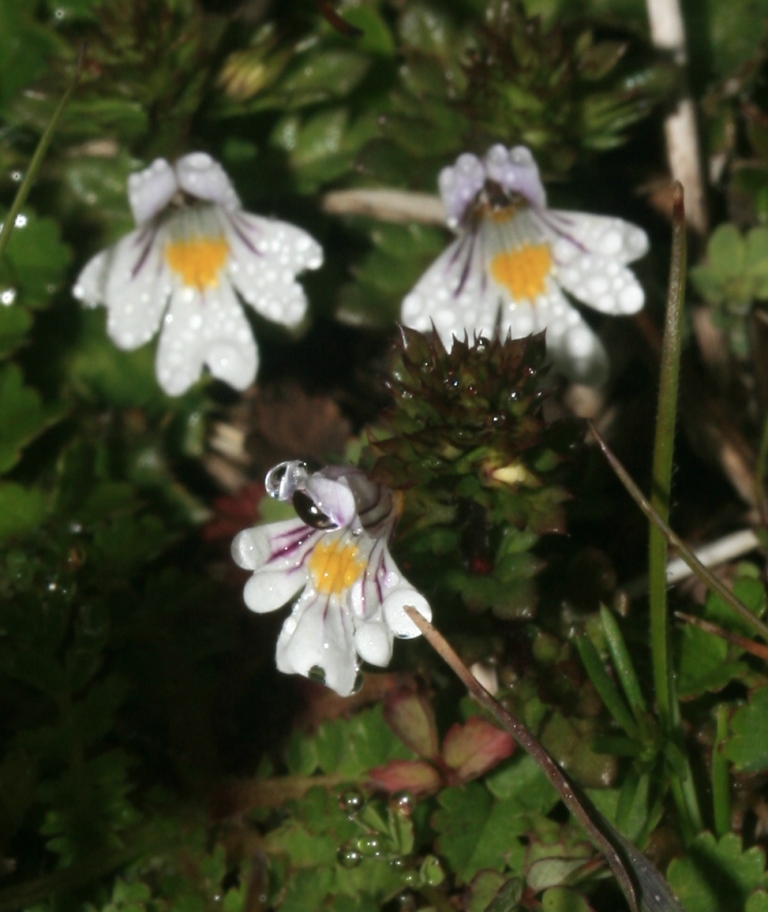
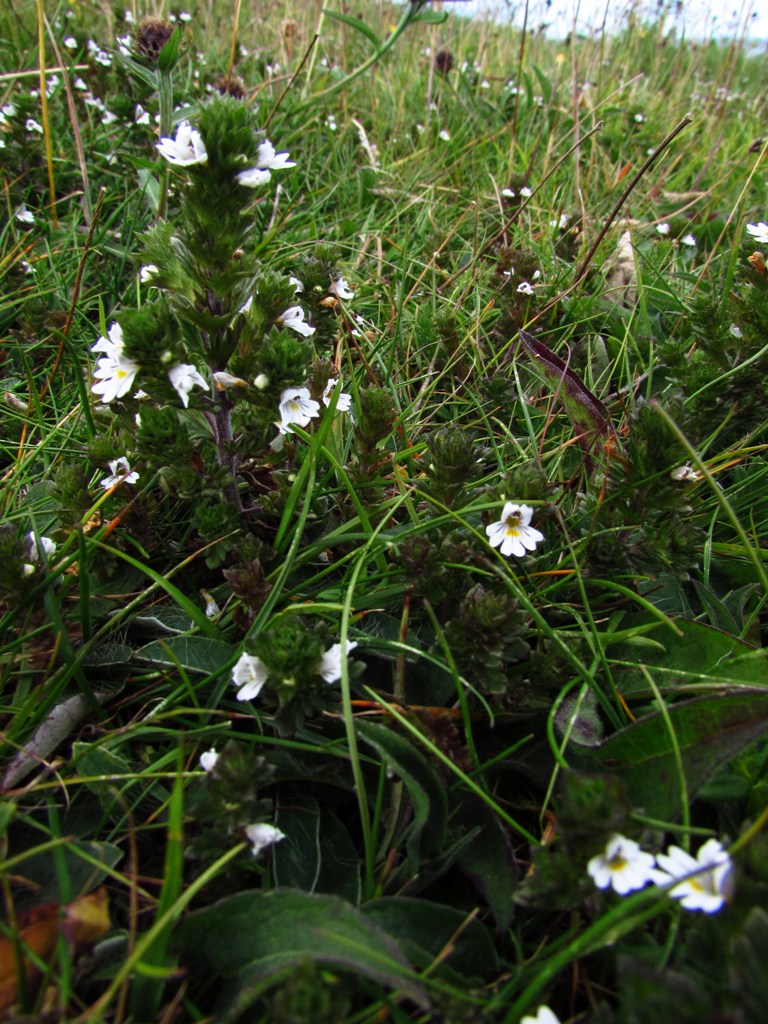
Euphrasia spp or Eyebrights (by M. S.)
Euphrasia spp or Eyebrights
Euphrasia, or eyebright, is a genus of about 450 species of herbaceous flowering plants and has a cosmopolitan distribution. They are semi-parasitic on grasses and other plants. The common name refers to the plant’s use in treating eye infections.
Many Floras only list just Euphrasia officinalis agg or sensu lato as the identification is a specialised and difficult job also because there are many hybrids.
‘This is not one species but actually a complex of many separate but somewhat similar species which are semi-parasitic on grasses and other plants.’
Medicinal and Traditional Uses:
The plant was known to classical herbalists, but then was not referred to until mentioned again in 1305. Nicholas Culpeper assigned it to the Zodiac sign Leo, claiming that it strengthened the brain. It was also used to treat bad memory and vertigo.
In the Elizabethan era, the plant was used in ales, and Gervase Markham‘s Countrie Farm (1616) said that one should “Drinke everie morning a small draught of Eyebright wine.”
Herbalists use eyebright as a poultice with or without concurrent administration of a tea for the redness, swelling, and visual disturbances caused by blepharitis, and conjunctivitis. The herb is also used for eyestrain and to relieve inflammation caused by colds, coughs, sinus infections, sore throats, and hay fever. Also see here.
Group 1: Subsection Euphrasia
- E. officinalis sensu lato/ E. anglica or Common Eyebright
- E. rivularis or Cumbrian Eyebright (picture)
- E. vigursii or Cornish Eyebright
Group 2: Subsection Euphrasia
- E. arctica (subsp arctica & subsp. borealis)or Arctic Eyebright
- E. tetraquetra or Western Eyebright
- E. nemerosa or Common Eyebright
- E. pseudokerneri or Chalk Eyebright
- E. confusa or Confused Eyebright
- E. frigida or Upland Eyebright
- E. foulaensis or Foula Eyebright
- E. cambrica or Welsh Eyebright
- E. ostenfeldii or Ostenfeld’s Eyebright
- E. marshallii or Marshall’s Eyebright
- E. rotundifolia or Pugley’s Eyebright
- E. campbelliae or Campbell’s Eyebright
- E. micrantha or Slender Eyebright
- E. scottica or Scottish Eyebright
- E. heslop-harrisonii or Heslop-Harrison’s Eyebright
Group 3: Subsection Angustifoliae
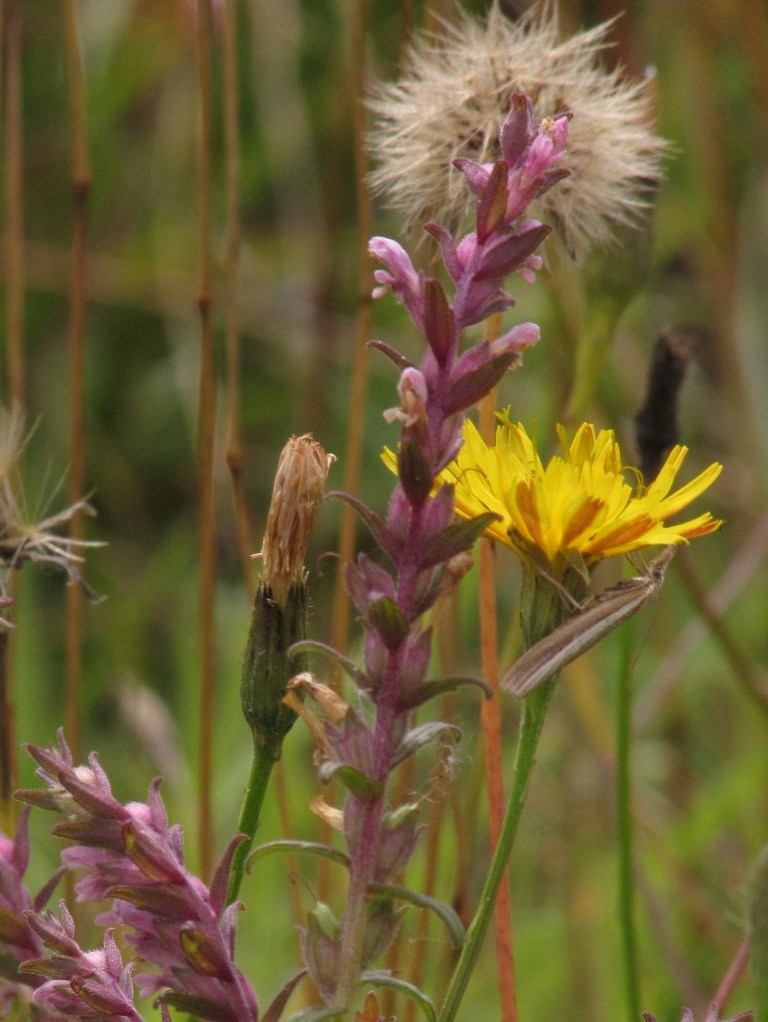
Odontitis vernus or Red Bartsia
O. jaubertianus or French Bartsia
Bartsia alpina or Alpine Bartsia
A shortly rhizomatous perennial of base-rich soils. In England it is a plant of the drier hummocks in basic flushes and runnels in damp upland pastures, and of steep, flushed, species-rich banks. In the Breadalbanes (Mid Perth) it grows on the periodically inundated ledges of mica-schist crags. Seed-set is poor.
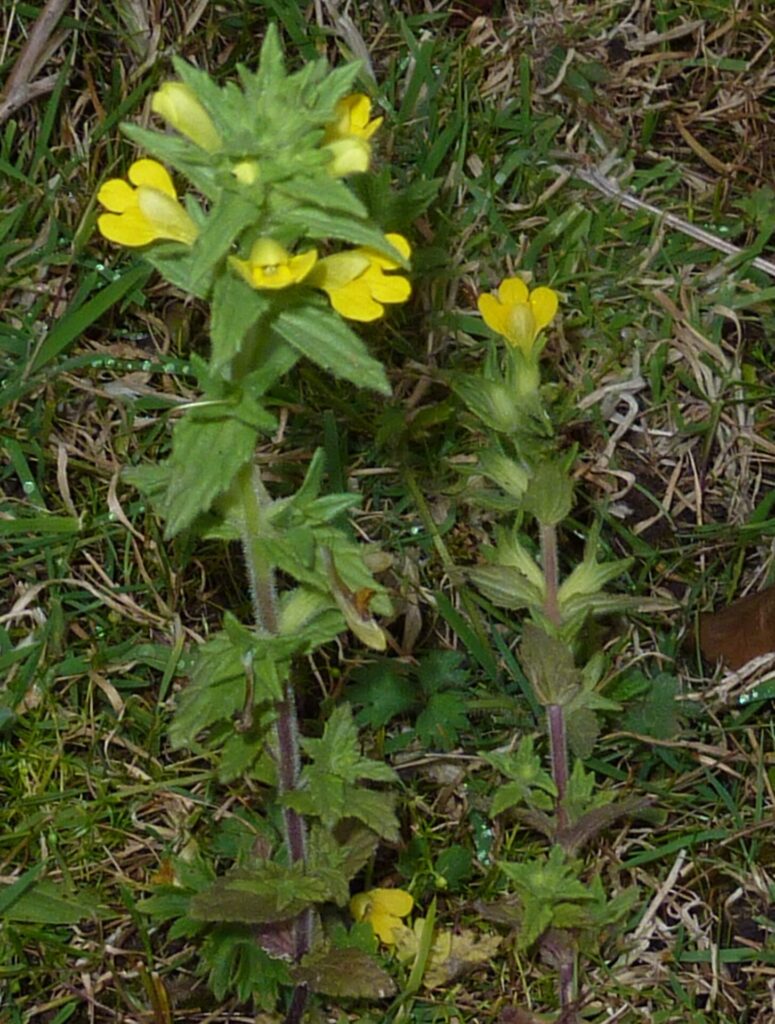
Parentucellia viscosa or Yellow Bartsia
A hemiparasitic annual of damp, open grassy places on sandy soils, often by tracks. It normally occurs in drier dune-slacks and in reclaimed heath-pasture, but is also found on pathsides, rough and scrubby grassland and field-borders, and increasingly in re-seeded amenity grasslands and waste places. It thrives on disturbance.
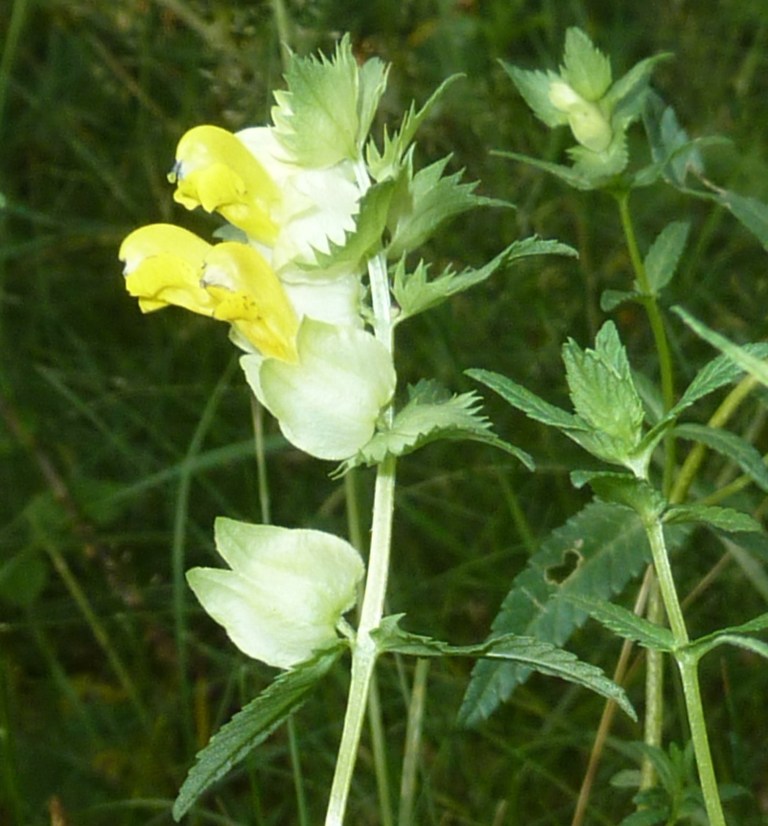
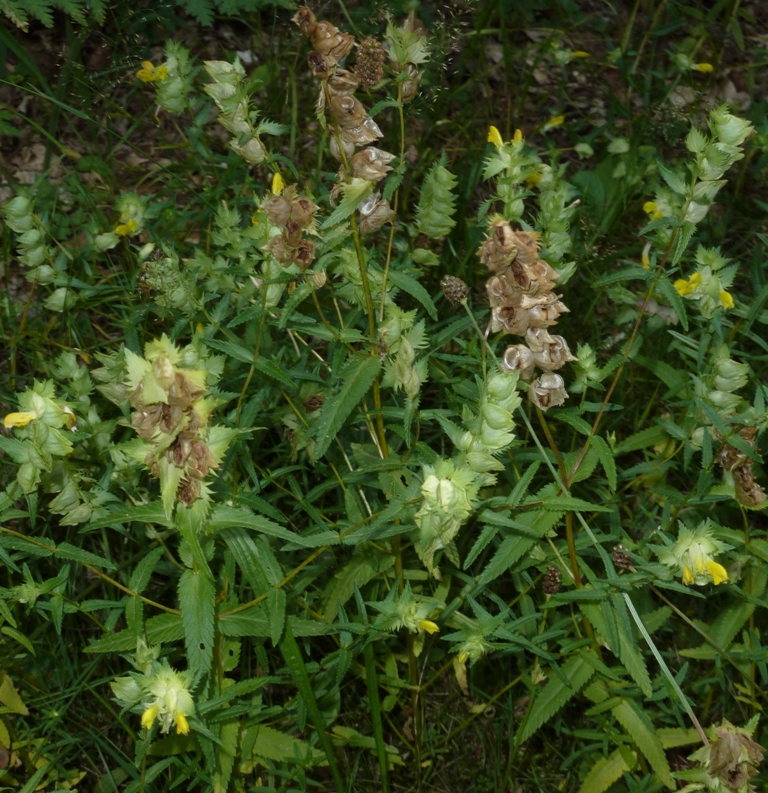
Rhinanthus minor or Yellow-rattle
An annual root-hemiparasite of nutrient-poor grasslands, including permanent pastures, hay meadows, the drier parts of fens, flushes in lowland and upland grasslands, and on montane ledges; also on roadsides and waste ground.
Yellow rattle is used to create or restore wildflower meadows, where it maintains species diversity by suppressing dominant grasses and the recycling of soil nutrients. The seed is sown thinly onto grassland from August to November—to germinate the following spring, the seeds need to remain in the soil throughout the winter months.
Research, including that at the UK’s Centre for Ecology and Hydrology, has shown that encouraging it to grow in hay meadows greatly increases biodiversity, by restricting grass growth and thereby allowing other species to thrive.
There are 6 subspecies described in Stace:
- R. minor ssp. minor
- R. minor ssp.stenophyllus
- R. minor ssp. monticola
- R. minor ssp. calcareus
- R. minor ssp. lintonii
- R. minor ssp. borealis
Rhinanthus angustifolius or Greater Yellow-rattle (Neophyte)
This annual root-parasite was formerly a widespread weed of arable land in E. Britain. However, most of the remaining sites are on the North Downs, in grassland and open scrub on chalk. In Lincolnshire, it occurs on peat in an area of cleared Pteridium and on railway ballast. In Angus, a tiny colony survives in sandy coastal grassland.
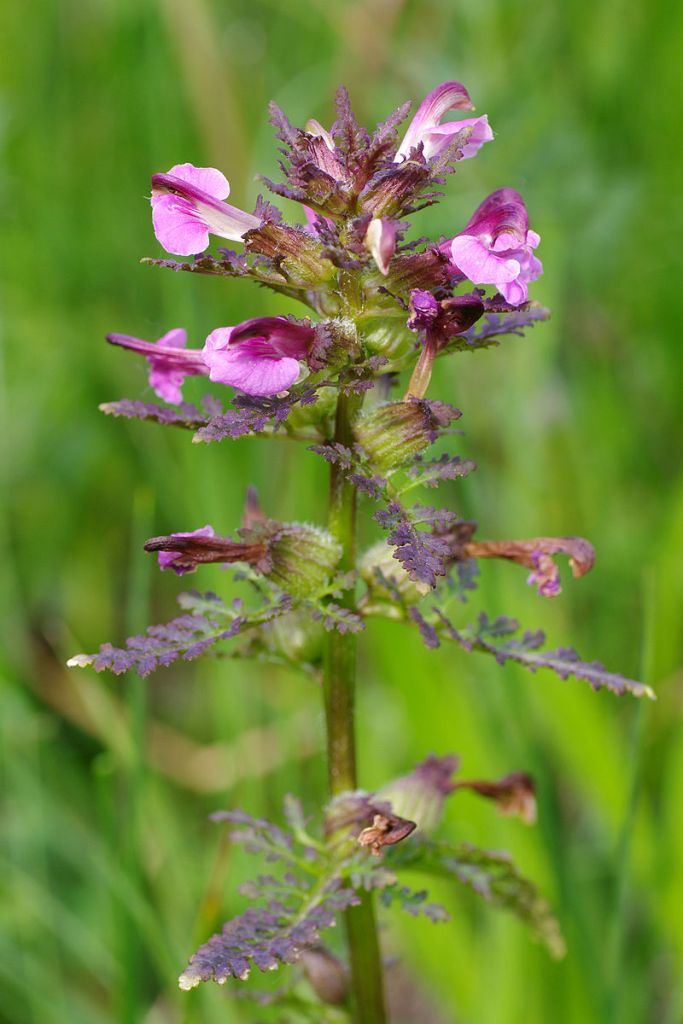
Pedicularis palustris or Marsh Lousewort
An annual to biennial root-hemiparasitic herb of a wide range of base-rich to acidic, moist habitats, including wet heaths, valley bogs, wet meadows, ditches, fens and hillside flushes. Its sites are usually more enriched than those preferred by P. sylvatica.
The flowers are pollinated by honey bees and bumblebees; these land on the lower lip, which droops under their weight allowing them to thrust their head inside the flower and extract the nectar, getting powdered with pollen at the same time.
P. sylvatica or Lousewort
A perennial, rarely biennial, root-hemiparasitic of acidic soils, found on damp grassy heaths, moorlands, upland flushed grasslands and the drier parts of bogs and marshes.
- P. sylvatica ssp. sylvatica
- P. sylvatica ssp. hibernica
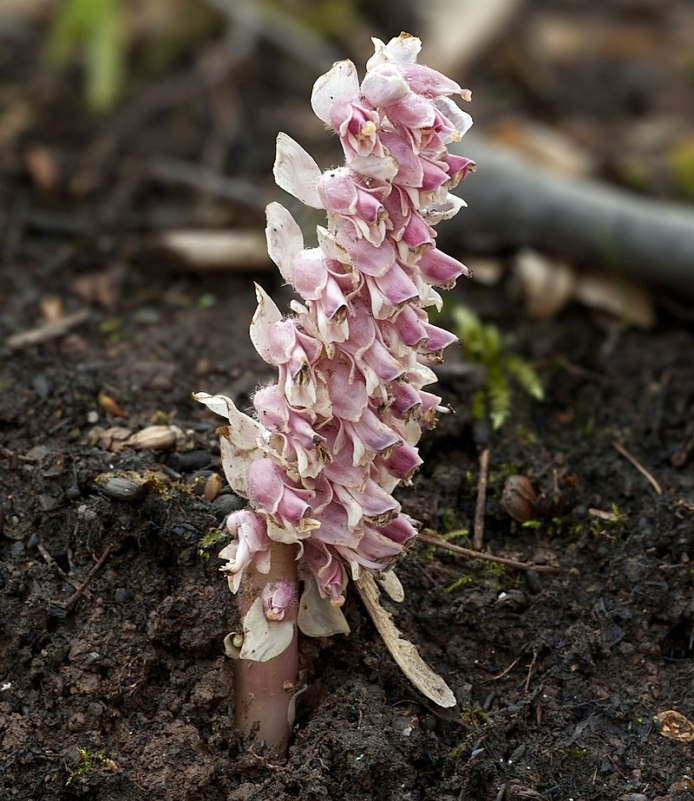
Lathraea squamaria or CommonToothwort
An annual or perennial herb, parasitic on the roots of a range of woody plants, especially Corylus, Fraxinus and Ulmus glabra. Its typical habitats include deciduous woodland, hedgerows, and river and stream banks.
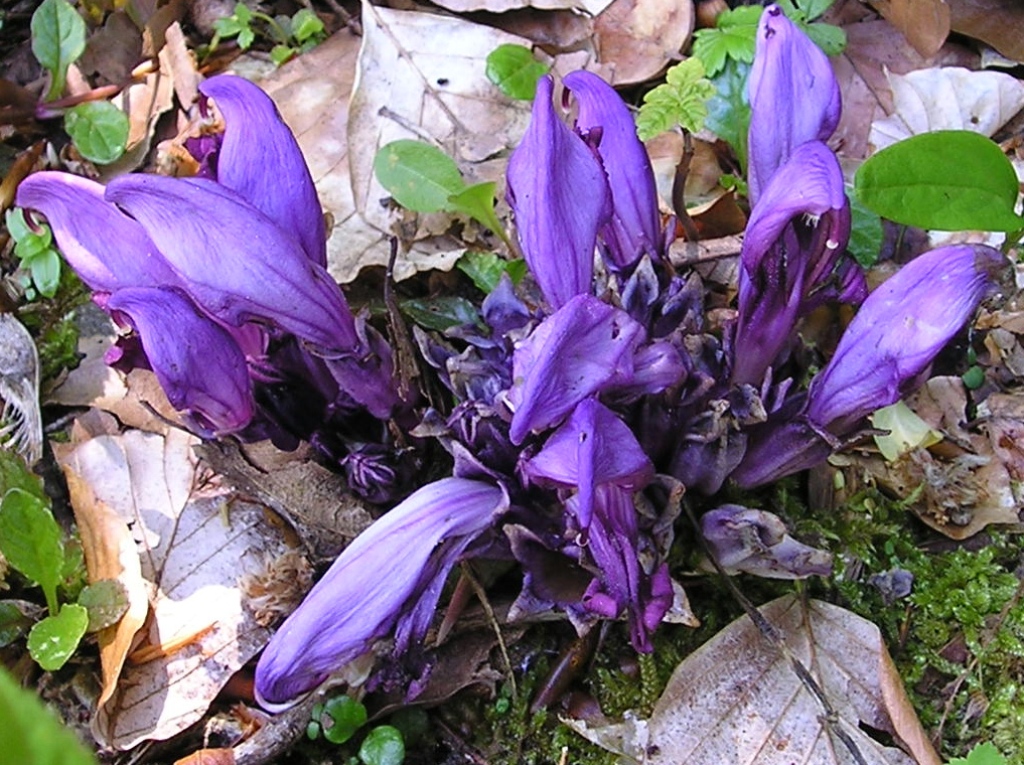
L. clandestina or Purple Toothwort
A root parasite mainly found on species of Alnus, Salix and Populus. It usually occurs in damp, shaded places in open woodland, coppices and along hedgerows, and especially near stream and river margins where dispersal may be effected by flood water. (Neophyte)
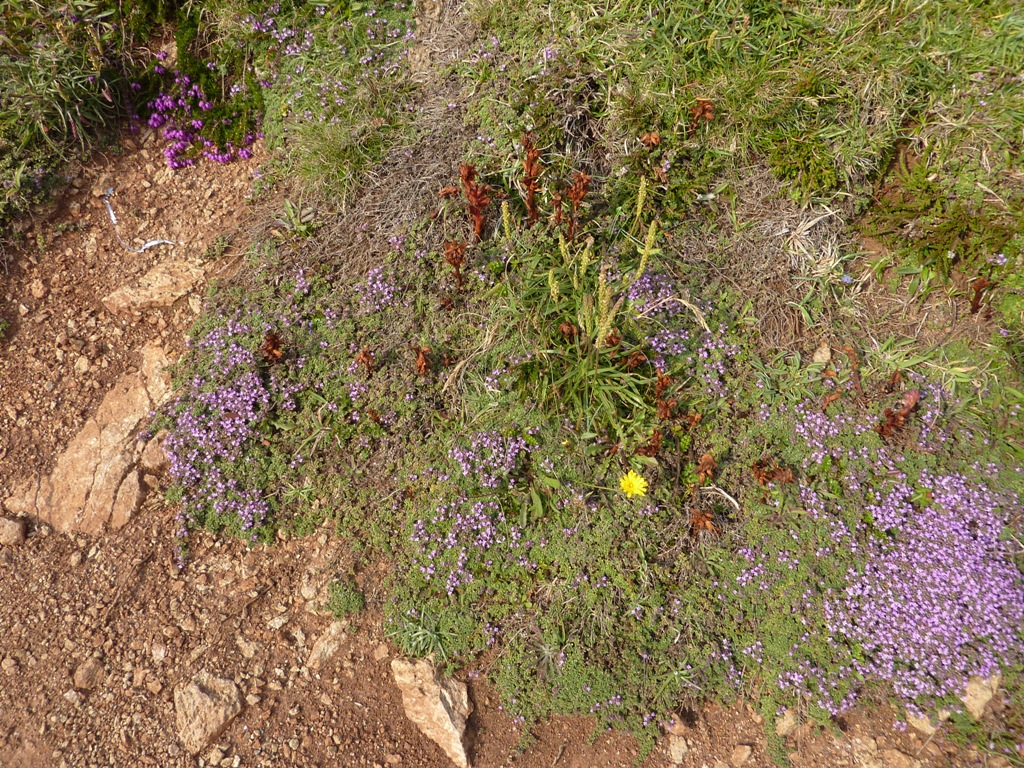
Orobanche alba or Thyme Broomrape amongst the purple thyme (by M. S.)
Orobanche sps. or Broomrapes
The name Broomrape is a combination of the term ‘broom’, referring to a vetch-like plant which is often parasitised, and ‘rape’, which come from the Latin ‘rapum’ meaning turnip or tuber, to describe the lumpy node it uses to attach itself to the host plant.
As they have no chlorophyll, the broomrapes are totally dependent on other plants for nutrients. Broomrape seeds remain dormant in the soil, often for many years, until stimulated to germinate by certain compounds produced by living plant roots. Broomrape seedlings put out a root-like growth, which attaches to the roots of nearby hosts. Once attached to a host, the broomrape robs its host of water and nutrients.
Some species are only able to parasitise a single plant species, and they are often named after the plant they parasitise, such as ivy broomrape (O. hederae) being restricted to parasitising ivy. Others can infect several genera, such as the lesser broomrape O. minor, which lives on clover and other related Fabaceae.
Branched broomrape Orobanche ramosa, native to central and southwestern Europe but widely naturalised elsewhere, is considered a major threat to crops in some areas. Plants that it targets are tomato, eggplant, potato, cabbage, coleus, bell pepper, sunflower, celery, and beans. In heavily infested areas, branched broomrape can cause total crop failure.
The bean broomrape Orobanche crenata, which targets the fava bean, has stems that are gathered and eaten in the region of Apulia, in southern Italy, where they are given the name of sporchia.
Orobanche spp. are increasingly being used for tonic purposes in China. Their ethnopharmacological background suggests potential usages as healthy foods and food supplements. They have the potential to be developed into herbal medicines for tonifying the kidney, against impotence and spermatorrhea, dermatological problems and wounds, as well as infantile diarrhoea.
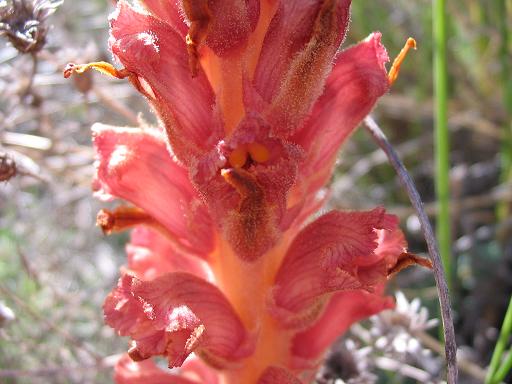
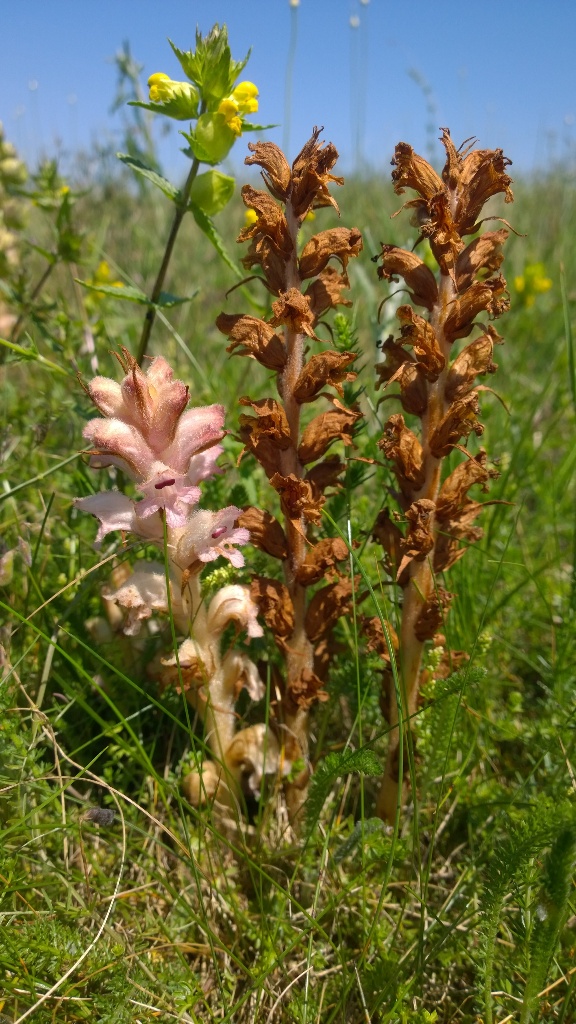
Apparently perennial, this species is almost exclusively parasitic upon Centaurea scabiosa, and is mainly found in chalk and limestone grassland.
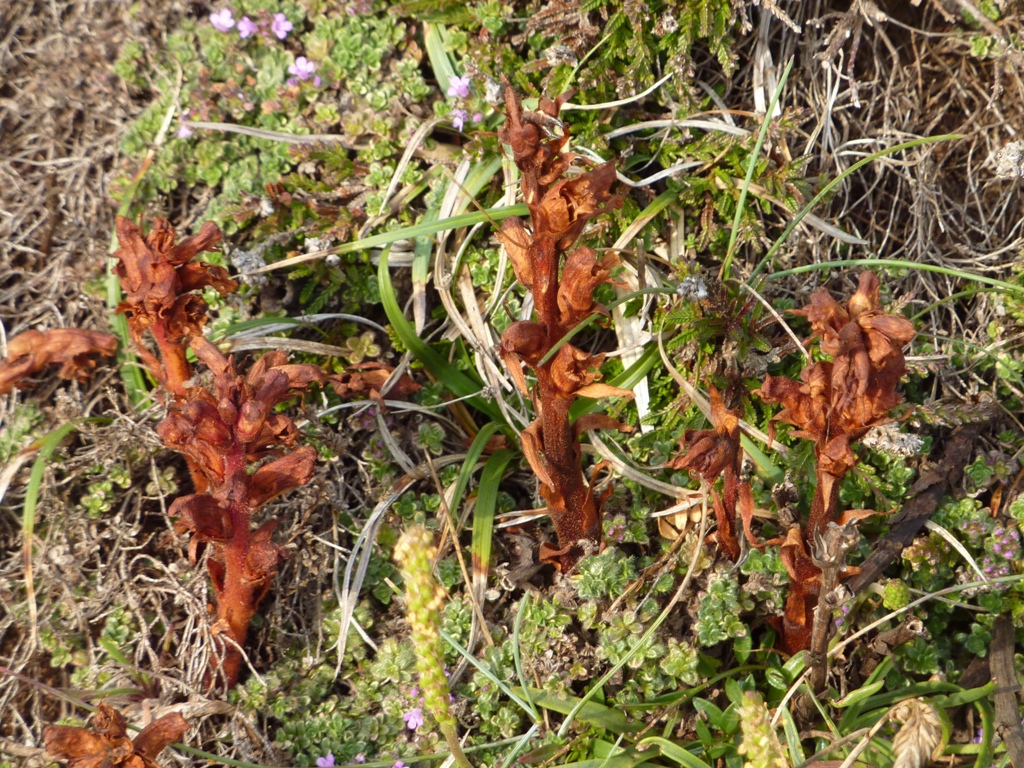
- O. alba or Thyme Broomrape (see also main picture at the start of this post)
An annual, or possibly perennial, root parasite of Thymus polytrichus. Its principal habitat is base-rich rocky coastal slopes, but it also occurs inland on stabilised scree below limestone outcrops in N. England.
- O. reticulata ssp. pallidiflora or Thistle Broomrape
- O. artemisiae-campestris or Oxtongue Broomrape
- O. crenata or Bean Broomrape (Neophyte)
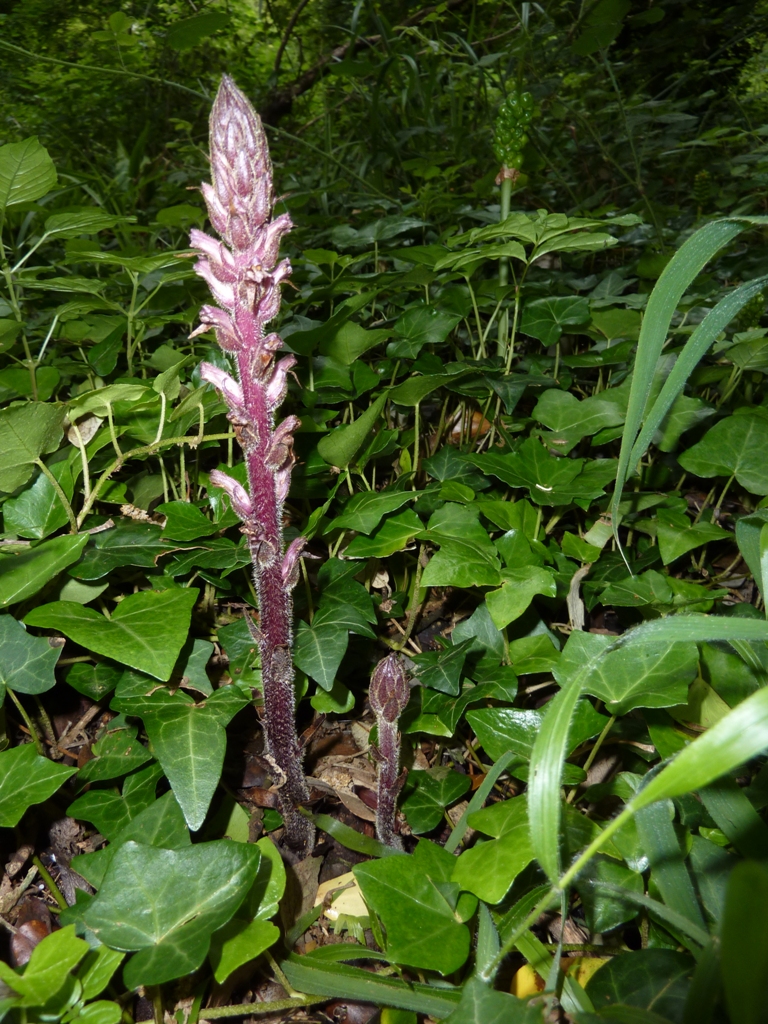
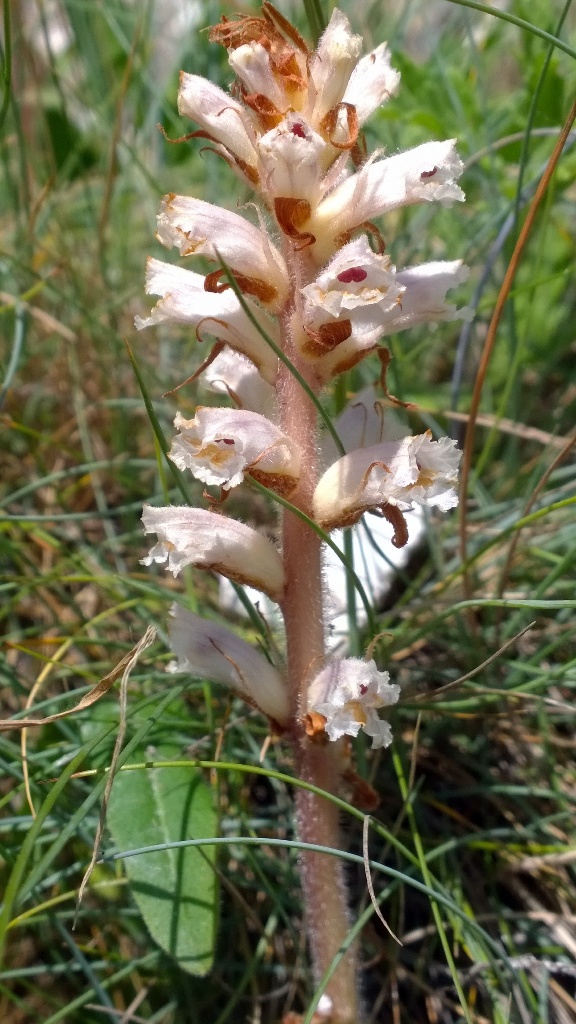
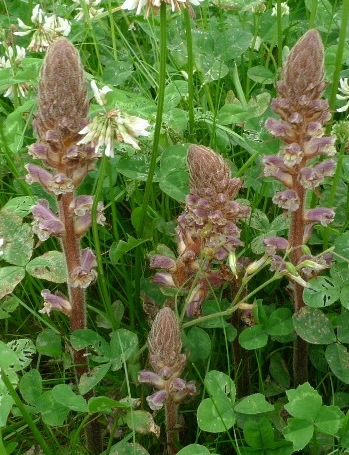
- O. minor or Common Broomrape with 2 ssp:
- O. minor ssp. minor and
- O. minor ssp. maritima
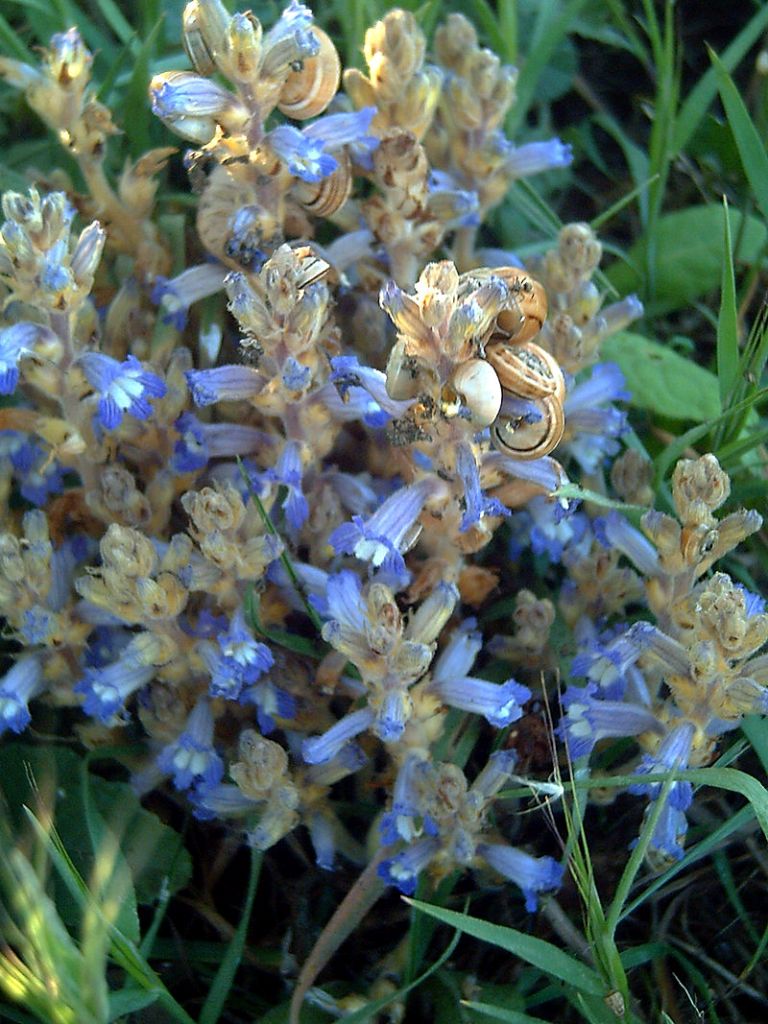
Phelipanche ramosa (syn. Orobanche ramosa) or Hemp Broomrape (Neophyte)
According to Stace this plant is from S. Europe, was formerly natd. especially in Cornwall, but not since 1928; it resembles a small, often branched, O. purpurea.
P. purpurea or Yarrow Broomrape
An annual or possibly perennial herb, P. purpurea is parasitic on Achillea millefolium. It typically occurs on dry, somewhat basic soils in cliff-top grassland and on roadsides and grassy banks, usually near the sea. Inland it has occurred in pasture, by allotments and in churchyard lawns as well as on roadsides. Flowers can reappear after decades of absence, suggesting that the seeds are long-lived or that plants can persist without flowering for many years.
